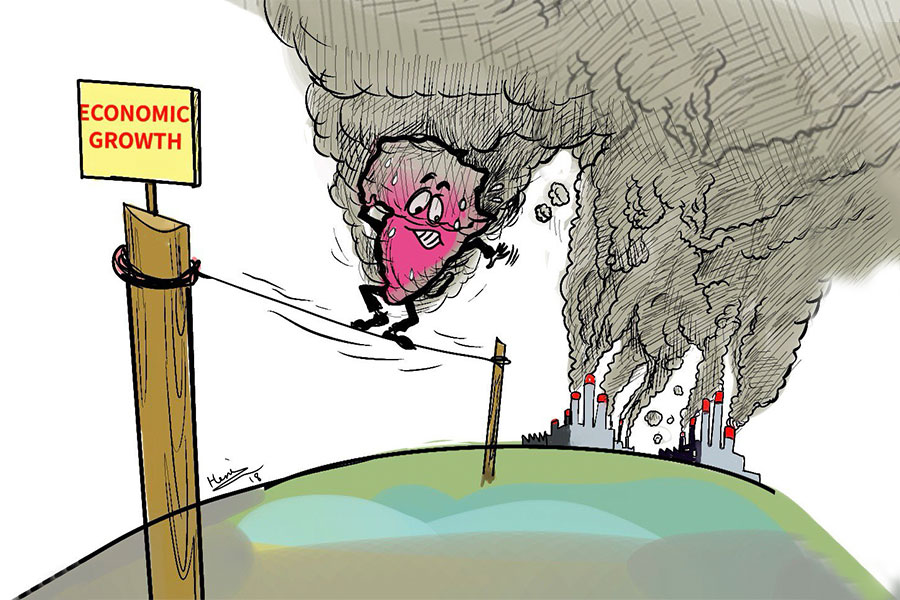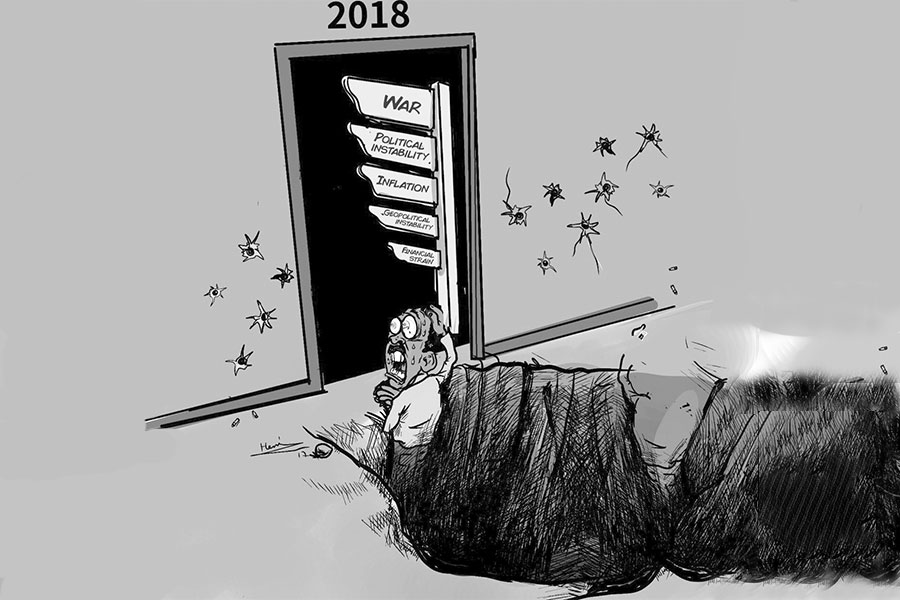In an industry characterised by tight liquidity, regulatory pressures, and growing credit risks, Addis International Bank (AdIB) posted robust financial results for the 2023/24 fiscal year, marking itself as a standout performer among peers and mid-tier financial institutions.
The Bank's net profit reached 413 million Br, surging by an impressive 85pc compared to the previous year, outpacing the industry's average net profit growth of around 32pc.
According to Aminu Nuru, a financial analyst based in Doha, Qatar, the remarkable increase, driven primarily by the Bank’s expansion of loan activities, foreign exchange operations, and digital banking services, proved its strong operational performance amid difficult market conditions.
However, despite its impressive growth, Addis Bank’s earnings remain modest compared to those of its competitors in the mid-tier league of the industry. Abay and Berhan banks reported substantially higher profits, 1.5 billion Br and 1.19 billion Br, respectively. Addis Bank's earnings constitute only a fraction of the private banking industry's total profits, which reached 22.2 billion Br, heavily dominated by larger banks such as Awash, Abyssinia, and Dashen.
Addis Bank’s total income increased by 44pc, reaching 2.4 billion Br, supported by a 34pc growth in interest income and a 66pc rise in fee and commission income. Bank officials attributed much of this growth to regulatory easing, especially the reduction in foreign exchange surrender requirements from 70pc to 50pc, which allowed banks to retain a larger portion of their foreign exchange earnings.
Hailu Alemu, the founding president of Addis Bank, believes strategic moves made during the fiscal year were instrumental in achieving positive results. He credited the diversification of revenue streams, loan portfolio expansion, strengthening of forex operations, and introduction of innovative digital banking products.
"We expanded our revenue streams by growing our loan book, strengthening our international banking segment, and introducing new digital products that boosted non-interest income,” Hailu told Fortune.
Despite this optimism, the sustainability of such impressive growth faces challenges.
Loan impairment charges sharply increased by 277pc, signalling growing credit risks. Industry analysts expressed concern that rising impairments, along with ongoing regulatory uncertainties, could potentially impact future profitability. Nonetheless, Hailu remained confident, banking on strategies that include further expansion of the loan portfolio, improved credit risk management, and leveraging favourable forex policies.
Hailu, who graduated in accounting and economics from Addis Abeba University, said the Bank plans to enhance digital banking services further, targeting higher fee-based income streams.
His optimism resonated among bank employees such as Mesfin Sileshi, manager of the AdIB's main branch on Jomo Kenyatta St., near the UNECA headquarters. According to Mesfin, a robust performance in forex generation was helpful despite ongoing constraints related to outstanding bonds held by the state-owned Development Bank of Ethiopia (DBE). He also noted that the floating exchange rate regime presented promising opportunities for the Bank.
Founded in 2012, Addis Bank began operations with an initial equity of 109.4 million Br raised from over 5,309 founding shareholders, including various community savings associations like Edir and farmers’ unions. Over the years, its shareholder base expanded, reaching 16,181 by the end of the latest fiscal period.
According to Shimelis Gedlegiorgis, a founding shareholder, immediate profits, though valuable, should be balanced against sustainable performance achieved through effective corporate governance, innovative product development, and robust staff training.
“Profitability will come later on,” Shimelis told Fortune.
The Bank maintained a conservative capital position, evident from a strong capital-to-asset ratio of 20.8pc, positioning it advantageously amidst evolving regulatory requirements. Its total assets grew 22.2pc year-on-year, reaching 15.4 billion Br. While commendable, this figure remains below the industry's average asset growth of 28pc and considerably smaller than mid-tier rivals like Abay Bank (66.4 billion Br) and Oromia Bank (114.6 billion Br). This posed a substantial challenge to Addis Bank in expanding its market share.
Customer confidence appeared strong, evidenced by steady growth in deposits, loans, and profits. Depositors increased notably, totaling nearly 720,000 at fiscal year-end. Deposits grew by approximately 21pc, reaching 11.1 billion Br, fueled by the opening of 24 new branches, bringing the total network to 156 branches nationwide. Analysts acknowledged that this expansion enhanced Addis Bank's market visibility and customer attraction capacity.
AdIB also posted a solid return on equity (RoE) of 21.8pc, demonstrating strong profitability amid industry-wide concerns such as inflation and rising operational costs linked to expansion. However, Addis Bank still trailed behind compared to larger banks like Awash and Abyssinia, which consistently recorded RoEs near 30pc. Its return on assets (RoA) stood at a respectable 2.9pc, demonstrating efficient utilisation of its asset base.
During the past fiscal year, Addis Bank's loans and advances grew by 14.5pc, still below the industry average of approximately 27pc. Nevertheless, the Bank’s loan-to-deposit ratio improved to 78pc, an enhancement from the previous year's 82.67pc, displaying more prudent liquidity management. Analysts such as Aminu noted this as a sign that the Bank can comfortably extend further credit while maintaining sound financial practices.
Hailu acknowledged the high concentration risks associated with export-focused lending, constituting 44.2pc of the Bank's total loan portfolio. He stated the importance of diversification strategies into sectors such as domestic trade, manufacturing, and construction to respond to potential credit risks.
Operational expenses increased notably during the year, with personnel costs rising 32.64pc, driven by branch expansion, wage adjustment, and additional recruitment. An unexpected surge of 128 million Br in expenses for security and janitorial services, outsourced to third-party providers, added to operational costs. Hailu justified these expenditures as essential investments to improve service quality and market competitiveness.
Despite rising expenses, Addis Bank maintained efficient cost management. Interest expenses accounted for roughly 35pc of total costs, helping sustain profitability. Earnings per share (EPS) improved from 12.91 Br to 20.44 Br, though still far below the industry average, signalling a continued need for growth to enhance shareholder value.
"We're working to control operational and administrative expenses to improve overall financial performance and shareholder returns," Hailu told Fortune.
Capital adequacy remained one of Addis Bank’s most impressive financial strengths, with a ratio previously approaching 30pc, higher than regulatory requirements. Nonetheless, the Bank faces future challenges about its capital. With current paid-up capital at 2.1 billion Br, Addis Bank remained behind the mandated five billion Birr threshold set for 2026, already surpassed by competitors like Abay Bank.
To address this capital shortfall, Hailu pinned his hope on shareholders' willingness to reinvest dividends, along with ongoing efforts to sell additional shares publicly. Board Chairman Kassahun Bekele echoed this sentiment, encouraging shareholders to prioritise reinvesting dividends to consolidate capital and sustain growth.
According to the analyst Aminu, continuous investment and innovation remain critical as the digital banking segment evolves rapidly.
Hailu concurred, noting that the financial industry is changing rapidly, with new entrants and fintech companies reshaping how consumers interact with financial services.
"To stay competitive, we're investing in digital transformation to streamline operations and improve customer experiences across digital and physical channels,” he told Fortune.
PUBLISHED ON
Mar 30, 2025 [ VOL
25 , NO
1300]

Dec 22 , 2024 . By TIZITA SHEWAFERAW
Charged with transforming colossal state-owned enterprises into modern and competitiv...

Aug 18 , 2024 . By AKSAH ITALO
Although predictable Yonas Zerihun's job in the ride-hailing service is not immune to...

Jul 28 , 2024 . By TIZITA SHEWAFERAW
Unhabitual, perhaps too many, Samuel Gebreyohannes, 38, used to occasionally enjoy a couple of beers at breakfast. However, he recently swit...

Jul 13 , 2024 . By AKSAH ITALO
Investors who rely on tractors, trucks, and field vehicles for commuting, transporting commodities, and f...

Sep 13 , 2025
At its launch in Nairobi two years ago, the Africa Climate Summit was billed as the f...

Sep 6 , 2025
The dawn of a new year is more than a simple turning of the calendar. It is a moment...

Aug 30 , 2025
For Germans, Otto von Bismarck is first remembered as the architect of a unified nati...

Aug 23 , 2025
Banks have a new obsession. After decades chasing deposits and, more recently, digita...